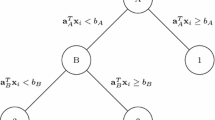Abstract
This article describes a heuristic for scheduling so-called ‘modular’ projects. Exact solutions to this NP-hard problem can be obtained with existing branch-and-bound and dynamic-programming algorithms, but only for small to medium-size instances. The proposed heuristic, by contrast, can be used even for large instances, or when instances are particularly difficult because of their characteristics, such as a low network density. The proposed heuristic draws from existing results in the literature on sequential testing, which will be briefly reviewed. The performance of the heuristic is assessed over a dataset of 360 instances.





Similar content being viewed by others
Notes
A strict (partial) order \(O\subset V\times V\) over a set \(V\) is a relation defined on \(V\) that is both asymmetric (\((i,j)\in O\) implies \((j,i)\not \in O\)) and transitive (\((i,j)\in O\) and \((j,l)\in O\) implies \((i,l)\in O\)).
To compute the transitive reduction of a poset \((V,O)\) we remove all elements \((i,l)\) of \(O\) for which there is an element \(j\in V\) such that \((i,j)\in O\) and \((j,l)\in O\).
Available online at http://feb.kuleuven.be/public/NDBAC96/MP1_instances.htm
References
Baldwin, C.Y., Clark, K.B.: Design Rules: The Power of Modularity. The MIT Press, Cambridge MA (2000)
Ben-Dov, Y.: A branch and bound algorithm for minimizing the expected cost of testing coherent systems. Eur. J. Oper. Res. 7(3), 284–289 (1981a)
Ben-Dov, Y.: Optimal testing procedures for special structures of coherent systems. Manag. Sci. 27(12), 1410–1420 (1981b)
Birnbaum, Z.W.: On the importance of different components in a multi-component system. In: Krishnaiah, P.R. (ed.) Multivariate Analysis-II, vol. 1913, pp. 15–26. Academic Press, New York (1969)
Butterworth, R.W.: Some reliability fault-testing models. Oper. Res. 20(2), 335–343 (1972)
Coolen, K., Wei, W., Talla Nobibon, F., Leus, R.: Project scheduling with modular project completion on a bottleneck resource. J. Sched. 17(1), 67–85 (2014)
Creemers, S., De Reyck, B., Leus, R.: Project planning with alternative technologies in uncertain environments. Eur. J.Oper. Res. doi:10.1016/j.ejor.2014.11.014 (2014)
De, P., Dunne, E.J., Gosh, J.B., Wells, C.E.: The discrete time/cost trade-off problem revisited. Eur. J. Oper. Res. 81, 225–238 (1995)
De Reyck, B., Demeulemeester, E.: Local search methods for the discrete time/resource trade-off problem in project networks. Naval Res. Logist. Q. 45, 553–578 (1998)
De Reyck, B., Leus, R.: R&D-project scheduling when activities may fail. IIE Trans. 40(4), 367–384 (2008)
Drexl, A.: Scheduling of project networks by job assignment. Manag. Sci. 37(12), 1590–1602 (1991)
Jain, V., Grossmann, I.E.: Resource-constrained scheduling of tests in new product development. Ind. Eng. Chem. Res. 38, 3013–3026 (1999)
Jȩdrzejowicz, P.: Minimizing the average cost of testing coherent systems: complexity and approximate algorithms. IEEE Trans. Reliab. R–32(1), 67–70 (1983)
Mitten, L.G.: An analytic solution to the least cost testing sequence problem. J. Ind. Eng. 11(1), 17 (1960)
Puterman, M.L.: Markov Decision Processes: Discrete Stochastic Dynamic Programming. Wiley, New York (1994)
Ranjbar, M., Davari, M.: An exact method for scheduling of the alternative technologies in R&D projects. Comput. Oper. Res. 40, 395–405 (2013)
Runarsson, T.P., Yao, X.: Stochastic ranking for constrained evolutionary optimization. IEEE Trans. Evolut. Comput. 4(3), 284–294 (2000)
Schmidt, C.W., Grossmann, I.E.: Optimization models for the scheduling of testing tasks in new product development. Ind. Eng. Chem. Res. 35, 3498–3510 (1996)
Talbot, F.B.: Resource-constrained project scheduling problem with time-resource trade-offs: the nonpreemptive case. Manag. Sci. 28, 1197–1210 (1982)
Ünlüyurt, T.: Sequential testing of complex systems: a review. Discret. Appl. Math. 142, 189–205 (2004)
Acknowledgments
The authors thank the two anonymous referees for their time and for the thoughtful suggestions, which have helped us improve the paper.
Author information
Authors and Affiliations
Corresponding author
Appendix: An instance with \(n=20\)
Appendix: An instance with \(n=20\)
In this appendix, for illustration purposes, we describe the outputs of the algorithms proposed in this text for the instance depicted in Fig. 6. The numerical data for this instance can be found in Table 5. The instance is part of the dataset (instance name \(g\_n20\_os6\_4\)).
The initial ordering generated by Greedy 1 is
which is easy to verify manually with the data from Table 5 and the pseudocode of Greedy 1. Greedy 2 removes jobs 1, 3 and 5 and the order of the modules is redetermined. In this case, the heuristic order of the modules does not change (\(L' = L''\) in lines 13-16 of the pseudocode of Greedy 2), and
The expected profit from \(L\) and \(L'\) is approximately 14.72 and 15.05, respectively, so Greedy 2 will return \(L'\). An optimal EMS policy found via B&B turns out to be slightly better, with an expected profit of 15.32. An optimal ordering is given by
this list is also found by the two implementations of Greedy 3.
Rights and permissions
About this article
Cite this article
Huysmans, M., Coolen, K., Talla Nobibon, F. et al. A fast greedy heuristic for scheduling modular projects. J Heuristics 21, 47–72 (2015). https://doi.org/10.1007/s10732-014-9272-z
Received:
Revised:
Accepted:
Published:
Issue Date:
DOI: https://doi.org/10.1007/s10732-014-9272-z





